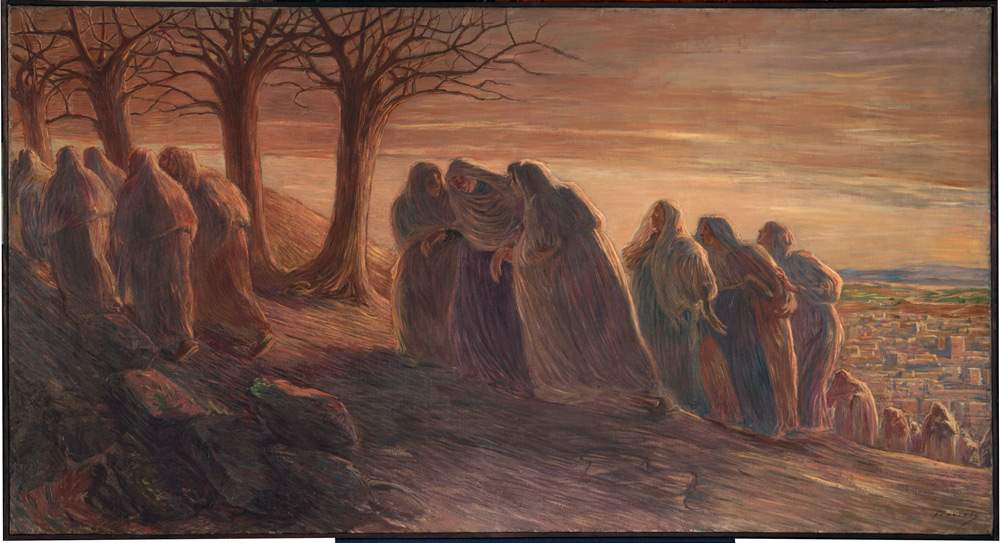Milan, an exhibition for Gaetano Previati's Via al Calvario, exhibited for the first time
The sacred art of Gaetano Previati (Ferrara, 1852 - Lavagna, 1920), the great master of pointillism, is the protagonist of an exhibition at the Diocesan Museum in Milan from February 20 to May 20, 2018: Gaetano Preivati (1852-1920). The Passion, set up on the occasion of the Lenten and Easter season and curated by Nadia Righi (director of the Diocesan Museum) and Micol Forti (director of the Vatican Museums’ Collection of Contemporary Art), intends in fact to present to the public Previati’s Via al Calvario, a recent acquisition of the Milanese museum, and the Via Crucis coming from the Vatican Museums, which collaborated in the realization of the exhibition. The exhibition opens precisely with The Way to Calvary, a painting that became part of the collection of the Diocesan Museum of Milan by bequest in his will: it is being shown to the public for the first time. It then continues with the entire Via Crucis cycle, painted entirely between 1901 and 1902, on loan from the Collection of Contemporary Art of the Vatican Museums, but also on display are the fourteen photographic reproductions of the works in the series, retouched with silver point by Previati himself and preserved in the church of Santi Quirico e Paolo in Dogliani (Cuneo).
The Via Crucis works were made for the 1902 Quadriennale in Turin. Long kept in the papal apartments, they are now on display in the Vatican Museums: they stand out for their luminism and for the grandeur and monumentality of the figure of Christ, all details that contribute to making the cycle one of the most powerful Vie Crucis ever created. Regarding these works, Micol Forti writes in the catalog, “consistent with the Divisionist researches experimented in the last decade, Previati renounces details and concentrates on the flow of the narrative, on the crossing of a single pictorial space, which coincides with the tragic space, in a sequence that unfolds in the chromatic and luministic flow of the scenes, entrusting the red of the chlamydia and the ochres and browns of the night hours as the leading thread of the tale.”
"An exhibition on the Via Crucis in this significant venue,“ says Barbara Jatta, director of the Vatican Museums, on the other hand, ”wants to seal that red thread that binds the artistic figure of Gaetano Previati, the city of Milan and its Diocese and the Vatican. Relations that have long roots in a path that unravels since the beginning of the twentieth century, finding an important moment of debut precisely in relation to the religious work of the Ferrara artist. The Vatican Way of the Cross and The Road to Calvary, recently acquired from the collections of the Diocesan Museum in Milan, represent the pinnacles of Previati’s activity of a sacred nature that became the object of an interesting and unexpected evaluation by the more progressive currents of the Church that were trying to formulate an updated and sustainable definition of contemporary religious art.
The exhibition can be visited during the museum’s opening hours: Tuesday through Sunday from 10 a.m. to 6 p.m. (the ticket office closes at 5:30 p.m.; the museum is closed on Mondays, except holidays). Tickets: full 8 euros, reduced 6 euros, reduced schools and oratories 4 euros. Combined ticket Diocesan Museum, exhibition, Museum of Sant’Eustorgio, Portinari Chapel and Early Christian Cemetery: full 10, reduced 8, reduced schools and oratories 6. Catalog published by Silvana Editoriale. Info at www.museodiocesano.it.
Image: Gaetano Previati, La via al Calvario (1901-1904; oil on canvas; Milan, Museo Diocesano Carlo Maria Martini)
 |
| Milan, an exhibition for Gaetano Previati's Via al Calvario, exhibited for the first time |
Warning: the translation into English of the original Italian article was created using automatic tools. We undertake to review all articles, but we do not guarantee the total absence of inaccuracies in the translation due to the program. You can find the original by clicking on the ITA button. If you find any mistake,please contact us.



























